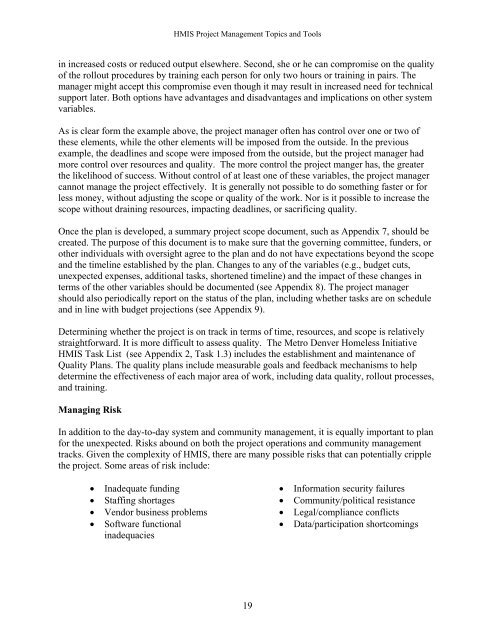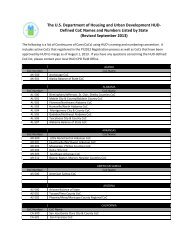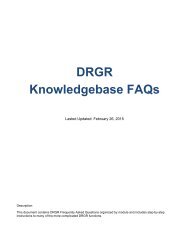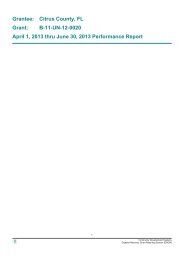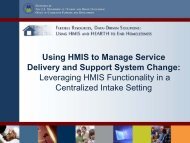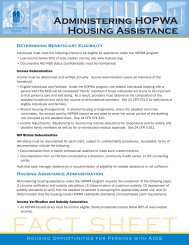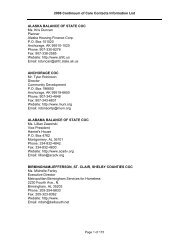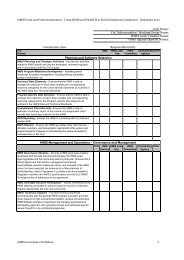HMIS Project Management Topics and Tools - OneCPD
HMIS Project Management Topics and Tools - OneCPD
HMIS Project Management Topics and Tools - OneCPD
- No tags were found...
You also want an ePaper? Increase the reach of your titles
YUMPU automatically turns print PDFs into web optimized ePapers that Google loves.
<strong>HMIS</strong> <strong>Project</strong> <strong>Management</strong> <strong>Topics</strong> <strong>and</strong> <strong>Tools</strong>in increased costs or reduced output elsewhere. Second, she or he can compromise on the qualityof the rollout procedures by training each person for only two hours or training in pairs. Themanager might accept this compromise even though it may result in increased need for technicalsupport later. Both options have advantages <strong>and</strong> disadvantages <strong>and</strong> implications on other systemvariables.As is clear form the example above, the project manager often has control over one or two ofthese elements, while the other elements will be imposed from the outside. In the previousexample, the deadlines <strong>and</strong> scope were imposed from the outside, but the project manager hadmore control over resources <strong>and</strong> quality. The more control the project manger has, the greaterthe likelihood of success. Without control of at least one of these variables, the project managercannot manage the project effectively. It is generally not possible to do something faster or forless money, without adjusting the scope or quality of the work. Nor is it possible to increase thescope without draining resources, impacting deadlines, or sacrificing quality.Once the plan is developed, a summary project scope document, such as Appendix 7, should becreated. The purpose of this document is to make sure that the governing committee, funders, orother individuals with oversight agree to the plan <strong>and</strong> do not have expectations beyond the scope<strong>and</strong> the timeline established by the plan. Changes to any of the variables (e.g., budget cuts,unexpected expenses, additional tasks, shortened timeline) <strong>and</strong> the impact of these changes interms of the other variables should be documented (see Appendix 8). The project managershould also periodically report on the status of the plan, including whether tasks are on schedule<strong>and</strong> in line with budget projections (see Appendix 9).Determining whether the project is on track in terms of time, resources, <strong>and</strong> scope is relativelystraightforward. It is more difficult to assess quality. The Metro Denver Homeless Initiative<strong>HMIS</strong> Task List (see Appendix 2, Task 1.3) includes the establishment <strong>and</strong> maintenance ofQuality Plans. The quality plans include measurable goals <strong>and</strong> feedback mechanisms to helpdetermine the effectiveness of each major area of work, including data quality, rollout processes,<strong>and</strong> training.Managing RiskIn addition to the day-to-day system <strong>and</strong> community management, it is equally important to planfor the unexpected. Risks abound on both the project operations <strong>and</strong> community managementtracks. Given the complexity of <strong>HMIS</strong>, there are many possible risks that can potentially cripplethe project. Some areas of risk include:• Inadequate funding• Staffing shortages• Vendor business problems• Software functionalinadequacies• Information security failures• Community/political resistance• Legal/compliance conflicts• Data/participation shortcomings19


